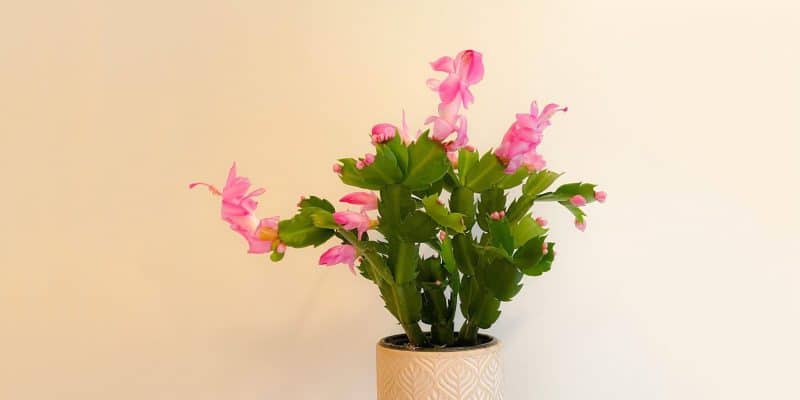Bringing a cactus home might seem like an unusual way to ring in the holidays, but there’s a good reason the Christmas cactus is a favorite yuletide accessory: It blooms from November to January!
So, if you’re ready to amp up your holiday décor game, or simply looking to add a touch of botanical cheer to your home during the colder months, we’re here to help you care for this beloved winter flowering houseplant.
We’ll cover everything you need to know about Christmas cactus care, including when to water and how to deal with bud drop.
Table of Contents
Christmas Cactus Plant Care Guide
History, Habitat, and Characteristics
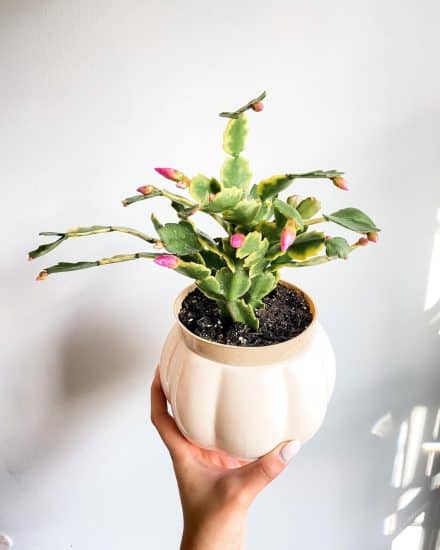
Christmas cactus (Schlumbergera × buckleyi) originated in the rainforests of Central and South America — not the usual stomping ground for cacti. This tropical epiphyte boasts a unique history and habitat that sets it apart from its desert cousins.
The Christmas cactus has a penchant for unconventional living, preferring to attach itself to trees and rocks in its native environment. Here, natural debris accumulates and decomposes, providing a loose, nutrient-rich medium for its roots to breathe and thrive.
This holiday cactus has rounded, scalloped leaves and drooping, tubular flowers in red, pink, white, or orange.
A wide variety of holiday cactus plants are often sold as Christmas cactus, but you can always identify Christmas cacti by those scalloped edges. Still, all holiday cacti are part of the Schlumbergera genus.
Here are the other common types of holiday cacti:
- Thanksgiving cactus (Schlumbergera truncata): Thanksgiving cacti stand out with sharp, serrated leaves. The Thanksgiving cactus blooms slightly earlier, typically in November, and will produce flowers in various shades of pink, red, and white.
- Easter cactus (Schlumbergera gaertneri): Also known as the Spring cactus, the Easter cactus blooms in late March to early April, boasting vibrant flowers in shades of pink, red, and orange. Its rounded leaves are less defined than the scalloped edges of Christmas cacti.
A key feature of Schlumbergera genera is their flattened, segmented stems, known as phylloclades. This adaptation means they don’t have true leaves. Instead, their green stems fill in for photosynthetic organs, allowing them to thrive in the lower-light conditions of rainforest understories.
Fun fact: Hybridization has played a significant role in the Christmas cactus’s story. In fact, some reports claim the Christmas cactus is a hybrid of the Thanksgiving and Easter cacti.
Christmas Cactus Bloom Cycle
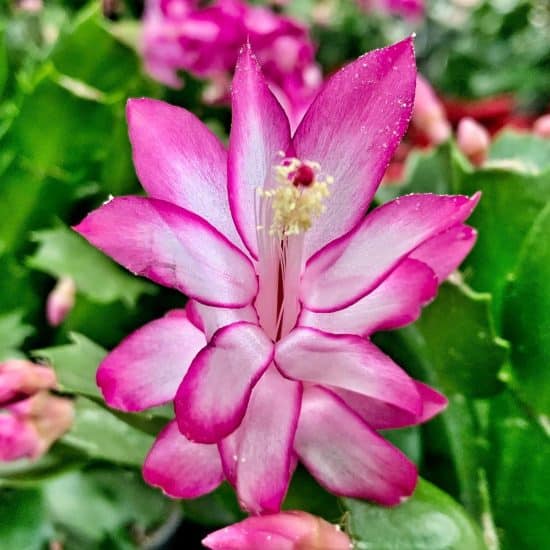
Characterized by its vibrant and showy flowers, the Christmas cactus typically blooms from late November to early January. Your Christmas cactus bloom cycle can be broken down into five main stages:
Stage 1: Dormancy period (late summer to early fall): During this stage, your Christmas cactus is busy preparing for the upcoming blooming season. Allowing the soil to dry out will encourage the plant to enter a rest period before it’s time to bloom.
Stage 2: Bud formation (mid to late fall): When temperatures drop in late fall, Christmas cactus flower buds form.
Stage 3: Bloom development (late fall): As the buds begin to grow, you’ll need to increase watering slightly to support the development of the flowers.
Stage 4: Full bloom (late November to early January): Your patience is now rewarded as your Christmas cactus bursts into a spectacular display of blossoms. During this stage, avoid relocating the plant. Changes in temperature and light can cause the blooms to wilt.
Stage 5: Post-bloom care (late January to early summer): After the Christmas cactus has finished blooming, it’s time to return to regular care.
Light
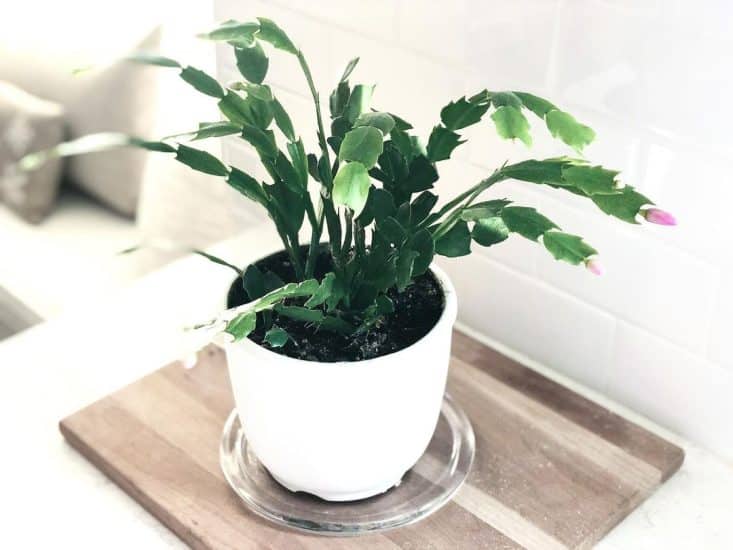
Remember, the Christmas cactus bloom cycle is promoted by its dormancy period, so it needs 12 to 14 hours of darkness in the fall. In general, though, bright indirect sunlight is ideal year-round. Direct sun is a no-no, though!
Look for these signs that your holiday cacti are getting too little light or too much light.
Not enough bright light:
- Slower growth
- Fewer blooms than expected
Keep in mind that too little light can prevent flowering. If you notice signs that your plant needs more light, move it to a slightly brighter spot where it can bask in indirect sunlight, such as near an east-facing window.
Too much direct sunlight:
- Pale, red, or pink flesh
- Wrinkling or burning, even holes
- Wilting
- Lack of new growth
If your plant’s foliage is looking a little worse for wear, relocate it away from direct sunlight, or use a sheer curtain to filter the light.
Water
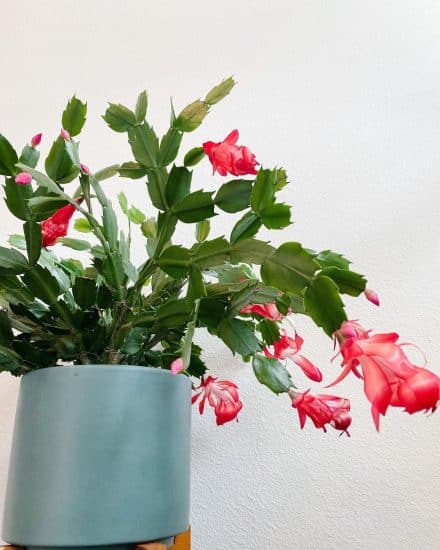
Water your Christmas cactus when the soil is dry to the touch. Be sure to water thoroughly, allowing the water to drain from the bottom of the pot, but don’t allow your plant to sit in standing water.
Although Christmas cacti like a good drink, overwatering can leave them feeling blue. Root damage and pad shriveling or swelling can occur if your plant spends too much time in soggy soil. Balancing watering frequency with proper drainage is essential to keeping your cactus content.
A thirsty Christmas cactus will show its displeasure through shriveled pads, signaling that it needs more frequent watering. Don’t let your festive friend be dry for too long — adjust your watering schedule to meet its needs and keep an eye on soil moisture.
Our watering tips:
- Maintain drier soil, and make it a habit to check the soil weekly, ensuring it’s dry before giving your Christmas cactus a drink.
- Let the excess water drain through the pot’s drainage holes to prevent overwatering and potential root damage.
- Remember that factors such as temperature, pot size, and time of year can affect how often your plant needs water — stay flexible and attentive to its changing needs.
Temperature and Humidity
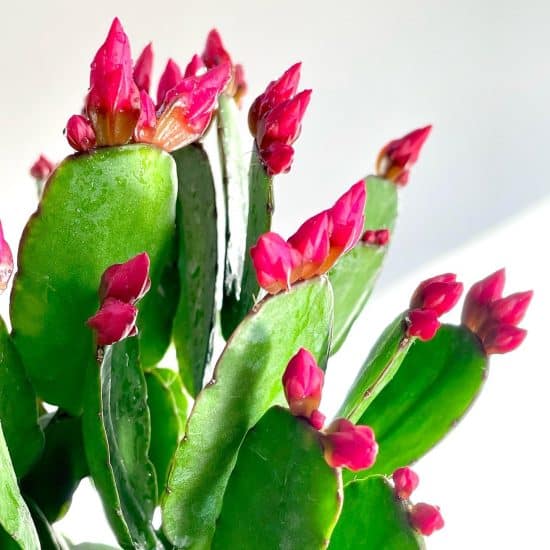
Christmas cacti thrive in temperatures between 65 and 75°F during the day, and slightly cooler temperatures at night. To see buds, lower temperatures ranging between 50 and 55°F at night are ideal.
Care for Christmas cactus means being mindful of sudden changes in light, temperature, or humidity, which can lead to dropping of buds. And don’t forget, Christmas cactus isn’t cold-hardy, so bring it inside when temperatures start to freeze.
As for humidity, holiday cacti like a bit of moisture in the air. Humidity levels around 40% to 50% will keep your Christmas cactus plant happy and healthy. If it’s not getting enough humidity, you might see wrinkled leaves or dry leaf tips. On the flip side, too much humidity can cause yellowing leaves and root damage.
Our humidity tips:
- Use a plant saucer filled with pebbles and water beneath the Christmas cactus. As the water evaporates, it’ll boost the humidity around the plant.
- Keep your Christmas cactus near other plants so they can share moisture through a process called transpiration.
- Run a humidifier in the room where your Christmas cactus lives.
- While not as effective for long-term humidity control, occasionally misting the leaves of your Christmas cactus can remove dust and potential pests like mealybugs.
Soil and Planting
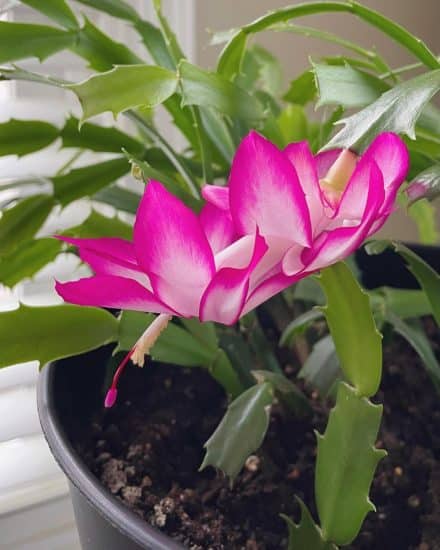
A well-draining growing medium gives your Christmas cactus the air it needs. You can either purchase a pre-made cactus mix or make your own blend by combining:
- 60% well-draining potting soil
- 40% perlite, pumice, or coarse sand
This formula allows the roots to breathe, promoting the overall well-being of the plant. You can also add compost or coconut coir, both of which are eco-friendly alternatives to the popular but unsustainable soil amendment peat moss.
Since Christmas cacti bloom best when pot-bound, repotting is only required every two to three years. Wait until after the Christmas bloom cycle, repotting in spring or early summer.
When choosing a new container, opt for one slightly larger than the current pot and ensure it has proper drainage holes to prevent too much moisture.
Fertilizer
To support healthy growth, fertilize your Christmas cactus once a month from spring to mid-summer when new stem segments appear. A balanced liquid houseplant fertilizer, diluted to 50% strength, should do the trick. However, avoid fertilizing right before or during the bloom cycle.
Keep an eye out for signs of over-fertilization, such as yellowing leaves, poor growth, or shriveled roots. If you suspect an issue, flush the soil with water to remove excess fertilizer and dial back the frequency of fertilizer applications.
Propagation
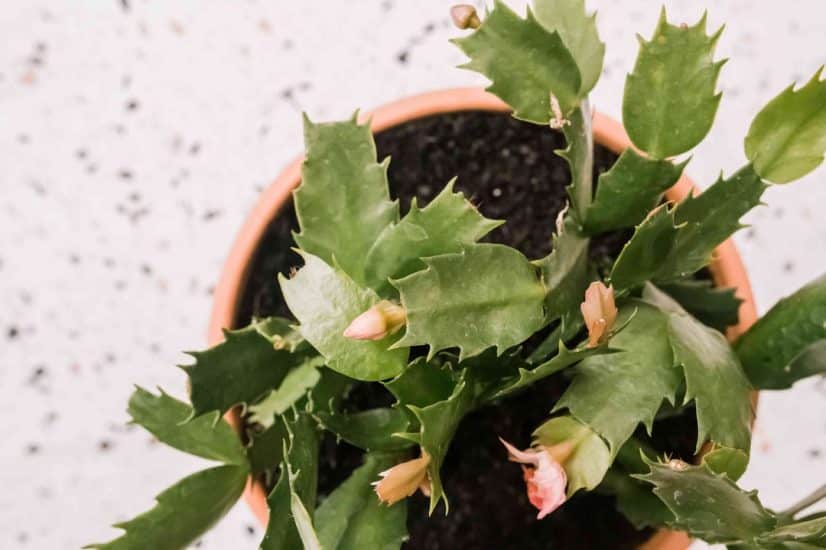
Propagating Christmas cactus is an exciting way to create new plants and share them with friends and family. Leaf cuttings are an easy, tried-and-true method.
Propagate Christmas cactus via leaf cuttings:
- Prune the plant by cutting between two leaf segments. Pick a healthy piece with at least two or three leaf segments. Use clean, sterilized gardening shears to keep your plant safe from infection. The best time to do this is in early spring or early winter when the plant begins producing new growth.
- Let the cuttings sit for a few days until the ends callus. The callus protects the cutting from infection and helps it absorb water more efficiently when planted in soil. Find a dry, shaded spot to place the cuttings while they develop the callus.
- Plant each cutting in a mix of cactus soil or a general potting mix with added perlite or sand for better drainage. Pop the callused end into the soil, making sure one or two leaf segments are above the soil surface. Gently press the soil around the cutting to ensure good contact.
- Keep the soil lightly moist for the first few weeks to help the roots grow. Put the pot in a bright spot with indirect sunlight to prevent drying out or scorching the cuttings. In a couple of weeks, the cutting should develop new roots.
Common Issues
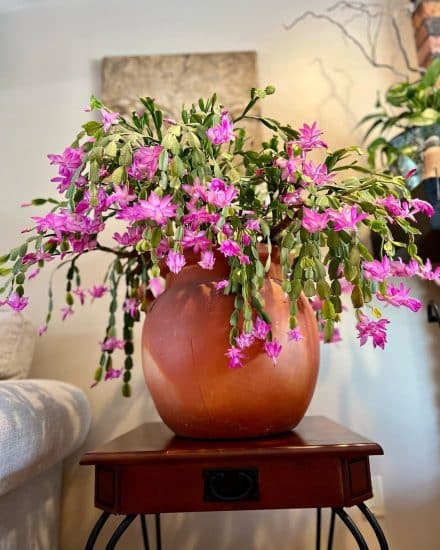
Christmas cacti are cherished for their spectacular blooms, and while they’re generally resilient houseplants, they can sometimes encounter a few issues.
Reddish Leaves
When the leaves of your Christmas cactus take on a reddish hue, it’s often a sign that the plant is getting too much sun.
If you notice a reddish tint on the edges or across the entire leaf surface, it’s time to take action. Move your plant to an east-facing window with bright, indirect sunlight to protect it from sunburn.
Bud Drop
If you find that the flower buds on your Christmas cactus are falling off before they have a chance to bloom, you’re likely experiencing bud drop. This frustrating issue is often caused by sudden changes in temperature, light, or humidity while the plant is in its blooming period.
To identify bud drop, look for unopened flower buds that have dropped from the cactus. To prevent this issue, strive to maintain consistent conditions for your plant during the blooming period. Keep the temperature stable, avoid relocating the plant to areas with drastically different light exposure, and ensure a humid environment.
Pests and Diseases
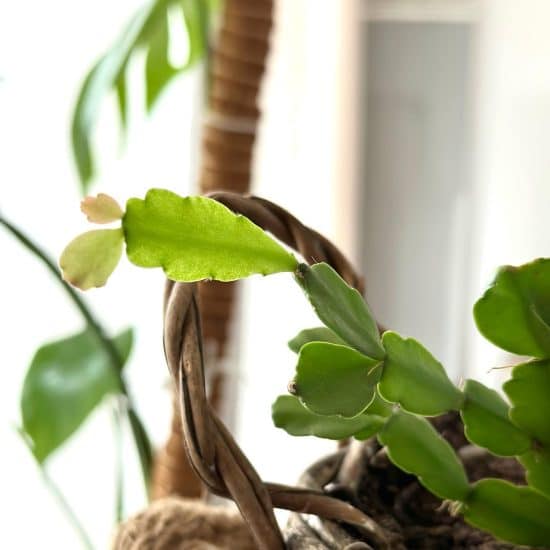
Christmas cacti are resilient plants, making them a delight to care for. However, even the hardiest plants face issues, mainly due to overwatering or stress.
Root Rot
Overwatering your Christmas cactus or using poorly draining soil can lead to root rot (nooo!). Symptoms to watch for include wilting, yellowing leaves, and a soft, mushy stem.
If you notice these signs, it’s time to take action:
- Gently remove the cactus from its pot and carefully trim away any affected roots — they’ll appear dark, soft, and slimy.
- Use clean, sterilized scissors to cut off any mushy or discolored parts of the stem.
- Give your plant a fresh start by repotting it in a sterile cactus mix with proper drainage. Don’t forget to choose a pot with a drainage hole.
- In the future, water cautiously, and maintain drier soil. Let the top inch of soil dry before giving your plant another drink.
Fungus Gnats
Overwatering not only causes root rot, but can also attract fungus gnats. These tiny winged insects love moist environments, like damp soil. Although they generally don’t harm the plant directly, their larvae can feast on the roots, eventually causing damage.
To spot fungus gnats, look for small black flies hovering around your cactus or crawling on the soil surface.
To bid farewell to fungus gnats, follow these steps:
- Allow the top inch of soil to dry out between waterings, which helps eliminate the moist conditions fungus gnats adore.
- Place yellow sticky traps near the plant to catch adult gnats.
- For more severe infestations, treat the soil with a safe, indoor plant insecticide or a natural solution like neem oil (always follow the product’s instructions), or repot with new soil.
Conclusion
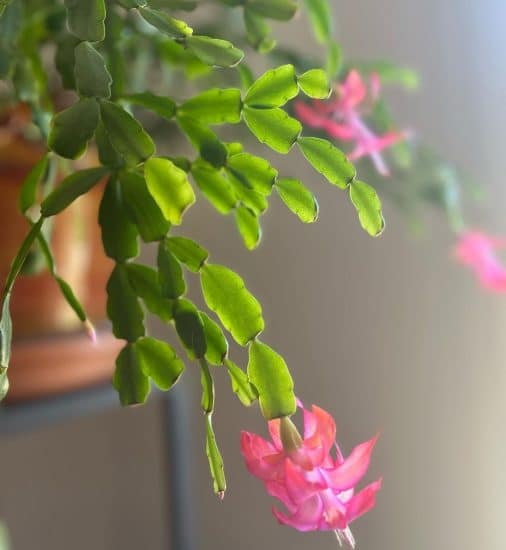
That’s a wrap for our Christmas cactus guide! We hope you’re feeling inspired and eager to care for a Christmas cactus, holiday season or not!
Christmas cactus care summary:
- Provide bright, indirect light, emulating the plant’s natural rainforest habitat — avoid direct sunlight.
- Water when the top inch of soil is dry, ensuring the soil is well-draining and the pot has adequate drainage holes.
- Maintain a temperature between 65 and 75°F during the day, and slightly cooler at night for optimal growth and flowering.
- Aim for humidity levels of 40% to 50%. Use a pebble tray, humidifier, or group with other plants to maintain ideal conditions.
- Use a well-draining cactus soil mix or create your own blend of potting soil and perlite, pumice, or coarse sand.
If you found it helpful, pass this guide along to friends and fellow plant lovers. And please, share your Christmas cactus success stories with us!
FAQ
How do I keep my Christmas cactus blooming?
One crucial factor for encouraging Christmas cactus blooms is temperature. Keep your cactus in a room where the temperature ranges between 60-65° F during the day and cools to 55-60° F at night. This cool nighttime temperature is essential for the plant to set buds.
What is the lifespan of a Christmas cactus?
Christmas cacti can have quite a long lifespan. If you care for a Christmas cactus properly, these resilient plants can live for decades. It’s not uncommon for a Christmas cactus to become a family heirloom, passed down through generations, continuing to grace homes with its colorful blooms each holiday season.

